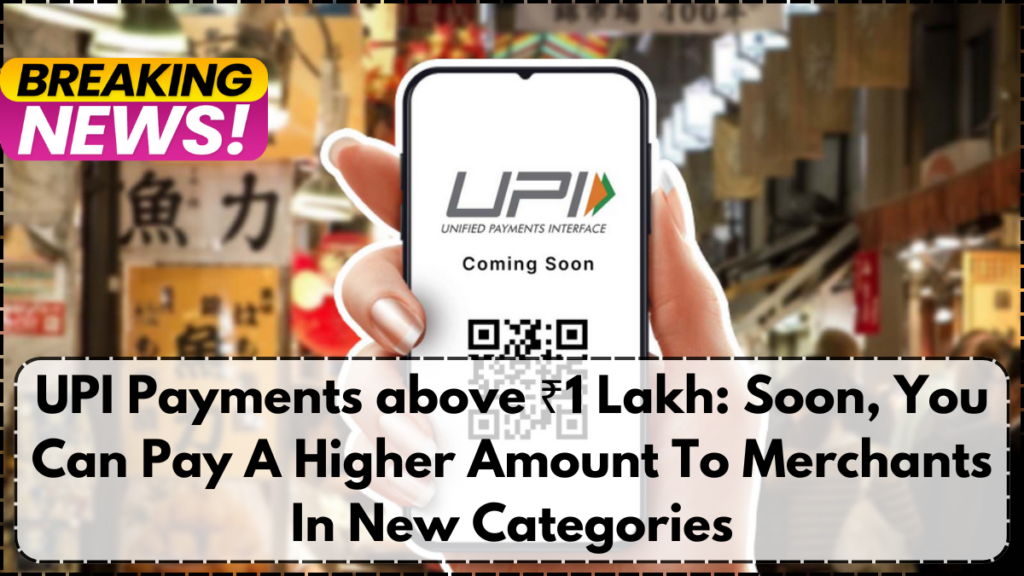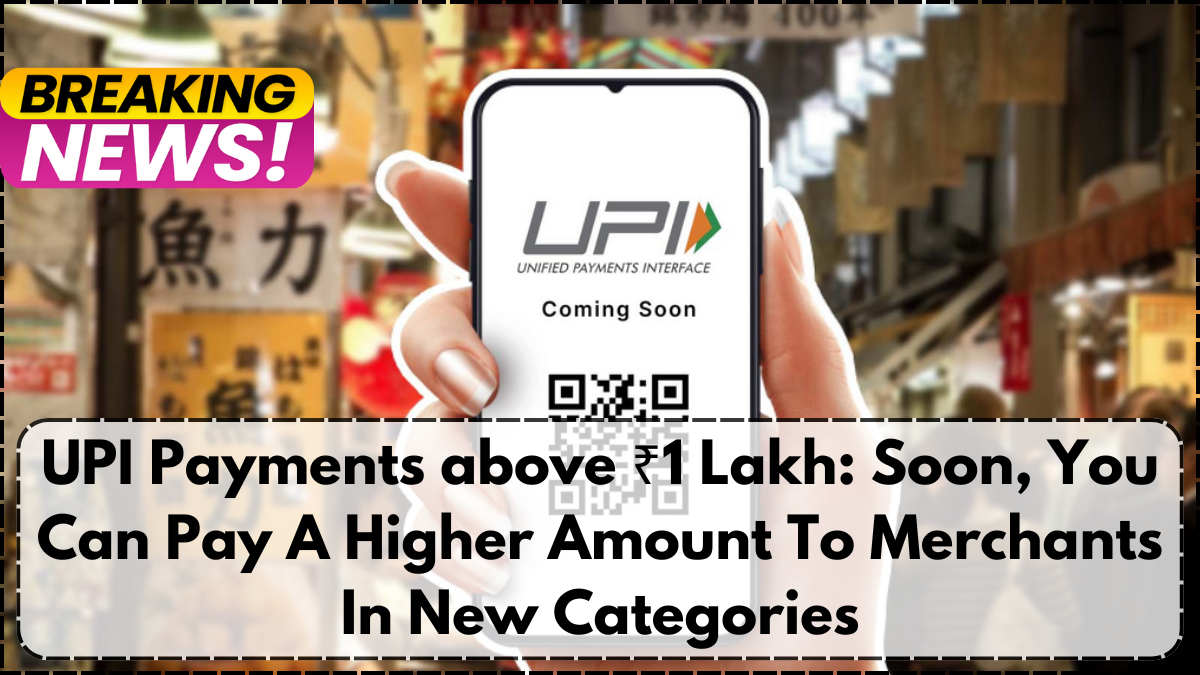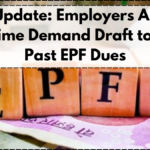In a major step toward evolving India’s digital payment landscape, the Reserve Bank of India (RBI) has announced plans to increase Unified Payments Interface (UPI) transaction limits for payments made to merchants (Person to Merchant or P2M). This move, confirmed by RBI Governor Sanjay Malhotra on April 9, 2025, is aimed at enhancing usability and catering to growing digital payment use cases.
As of now, the standard UPI transaction limit is ₹1 lakh for both person-to-person (P2P) and person-to-merchant (P2M) payments. However, certain P2M categories such as insurance premiums and tax-related payments already enjoy higher thresholds of ₹2 lakh and ₹5 lakh respectively. The proposed revision will allow more merchant segments to benefit from higher caps.

Why the Change?
The surge in digital transactions and growing acceptance of UPI across sectors—including healthcare, education, automotive, and international travel—has revealed limitations in the current cap. While P2P transactions will retain their existing ₹1 lakh ceiling, the RBI is giving the National Payments Corporation of India (NPCI) the authority to reassess and adjust P2M limits in collaboration with banks and stakeholders.
Potential Impacts of Higher P2M Limits
Here’s how the RBI’s decision could influence different sectors:
| Use Case | Current Issue | Impact of Revised Limit |
|---|---|---|
| International UPI Payments | Forex mismatch reduces effective value | Larger payments abroad possible |
| Education & Healthcare Fees | Need to split large payments | Single high-value UPI payment allowed |
| Automotive Down Payments | Limit restricts big-ticket purchases | Enables full down payments via UPI |
| Government & Tax Payments | Some limits already high | More sectors may be added |
| Micro & Small Businesses | Restricted on accepting large sums | Empowered to handle bigger sales |
Industry Experts Weigh In
Vishal Maru, Global Processing Head at FSS, applauds the move:
“Higher limits will remove hurdles for businesses, especially where high-ticket purchases are common. This change encourages innovation and deeper UPI adoption across sectors.”
Jai Kumar, Co-Founder of TechFini, explains:
“From paying full hospital bills to settling school fees, this makes life easier for consumers who otherwise had to split payments or revert to net banking. With proper security protocols, it can be a huge convenience booster.”
Rahul Jain, CFO at NTT DATA Payment Services India, adds a cautionary note:
“The extension of limits will likely depend on the merchant category’s risk profile. High-risk sectors may not benefit as much as low-risk ones like education or government services.”
International Payments Could Get a Boost
Currently, the Indian rupee’s relative weakness against foreign currencies makes existing UPI limits inadequate for overseas use. Since UPI is now accepted in countries like UAE, Singapore, and France, enhancing transaction caps will allow Indian travelers and NRIs to use UPI more seamlessly abroad.
Adhil Shetty, CEO of Bankbazaar.com, states:
“Cross-border UPI payments are a key use case. With more global partners onboarding, raising transaction thresholds is timely.”
Encouraging Larger Purchases via UPI
From buying a vehicle to making deposits at private hospitals, larger payments have often required traditional banking channels. The upcoming change could eliminate that dependency, enabling instant and secure transfers via UPI.
Anup Agrawal, CEO of Kiwi, summarizes:
“This helps micro, small, and medium enterprises (MSMEs) grow. They can now accept high-value payments directly, without investing in expensive payment infrastructure.”
UPI’s Average Ticket Size May Rise Again
Despite explosive growth in the number of UPI transactions—16 billion payments totaling ₹22 trillion in February 2025—the average ticket size has actually fallen. According to Shetty, it dropped from ₹1,510 in February 2024 to ₹1,364 in February 2025. This suggests that UPI is being increasingly used for micro-payments.
With higher P2M limits, larger transactions may increase the average ticket size once more.
What’s Next for NPCI?
The NPCI has already categorized sectors like insurance, education, tax payments, and initial public offerings (IPOs) under enhanced UPI limits. With this new framework, they’re now empowered to review and expand these categories further, aligning limits with evolving consumer demand.
Kumar from TechFini expects that more industries—especially low-risk ones—will be fast-tracked for enhanced caps in 2025.
Will Limits Be Reduced in the Future?
Despite the flexibility given to NPCI, experts say it is unlikely that UPI limits will be lowered for any segment.
Jain from NTT DATA reassures:
“The circular clearly focuses on expanding limits, not reducing them. Merchant restrictions below ₹1 lakh are not on the table.”
Conclusion
RBI’s strategic decision to empower NPCI with flexible control over P2M UPI limits marks a significant shift in India’s digital payment framework. This reform is expected to streamline high-value payments, foster broader UPI adoption, and unlock new business opportunities—both locally and globally. As NPCI evaluates and revises merchant categories over the coming months, stakeholders across industries should prepare for a more dynamic and inclusive UPI ecosystem in 2025.
FAQ
What is the current UPI transaction limit for merchant payments?
As of April 2025, the standard limit is ₹1 lakh, but specific categories such as insurance or taxes have limits up to ₹5 lakh.
Will the UPI P2P transaction limit change?
No, person-to-person UPI transactions will remain capped at ₹1 lakh.
When will the new UPI P2M limits be implemented?
Exact dates haven’t been confirmed yet, but NPCI is expected to announce revisions soon after stakeholder consultations.
Can I use UPI abroad with the new limit changes?
Yes, enhanced limits may make it easier to use UPI in foreign countries where it’s already accepted, like UAE, Singapore, and France.
Will all merchants get higher UPI limits?
Not necessarily. NPCI will evaluate and allow limit enhancements based on the risk category and use case of the merchant.
For More Information Click Here
Pari is a passionate writer known for captivating stories that blend imagination and reality. Inspired by travel, history, and everyday moments, Pari crafts narratives that resonate deeply with readers.




